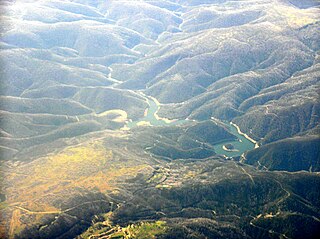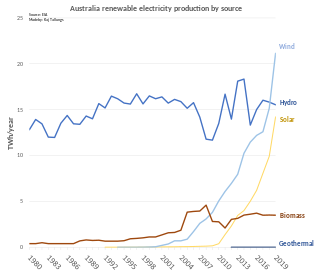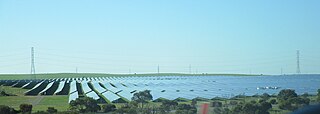
Pumped-storage hydroelectricity (PSH), or pumped hydroelectric energy storage (PHES), is a type of hydroelectric energy storage used by electric power systems for load balancing. The method stores energy in the form of gravitational potential energy of water, pumped from a lower elevation reservoir to a higher elevation. Low-cost surplus off-peak electric power is typically used to run the pumps. During periods of high electrical demand, the stored water is released through turbines to produce electric power. Although the losses of the pumping process make the plant a net consumer of energy overall, the system increases revenue by selling more electricity during periods of peak demand, when electricity prices are highest. If the upper lake collects significant rainfall or is fed by a river then the plant may be a net energy producer in the manner of a traditional hydroelectric plant.

The electricity sector in Canada has played a significant role in the economic and political life of the country since the late 19th century. The sector is organized along provincial and territorial lines. In a majority of provinces, large government-owned integrated public utilities play a leading role in the generation, transmission, and distribution of electricity. Ontario and Alberta have created electricity markets in the last decade to increase investment and competition in this sector of the economy.
Snowy Hydro Limited is an electricity generation and retailing company in Australia that owns, manages, and maintains the Snowy Mountains Hydro-electric Scheme which consists of nine hydro-electric power stations and sixteen large dams connected by 145 kilometres (90 mi) of tunnels and 80 kilometres (50 mi) of aqueducts located mainly in the Kosciuszko National Park. Snowy Hydro also owns and operates two gas-fired power stations in Victoria and one in New South Wales, three diesel power stations in South Australia and owns two electricity retailing businesses, Red Energy and Lumo Energy.

Manawa Energy limited is a New Zealand electricity generation company that offers bespoke electricity products to commercial and industrial customers across New Zealand. Manawa energy currently operate 26 power schemes from the Bay of Plenty in the north, to Otago in the south.

Guthega Power Station is located in the Snowy Mountains region of New South Wales, Australia. The power station's purpose is for the generation of electricity. It is the first to be completed and smallest of the initial seven hydroelectric power stations that comprise the Snowy Mountains Scheme, a vast hydroelectricity and irrigation complex constructed in south-east Australia between 1949 and 1974 and now run by Snowy Hydro.

The Murray Region Hydroelectric Power Stations refers to two of the original seven hydroelectric power stations, both located near the town of Khancoban in the Snowy Mountains region of New South Wales, Australia. The two power stations are part of the Snowy Mountains Scheme, a vast hydroelectricity and irrigation complex constructed in south-east Australia between 1949 and 1974 and now run by Snowy Hydro. Although both power stations are physically located in New South Wales, since 1 July 2008 all power generated has been allocated to the Victorian region of the National Electricity Market. The stations are not located on the Murray River.

The Tumut Hydroelectric Power Stations is a series of three hydroelectric power stations on the Tumut River in New South Wales, Australia, that are part of the Snowy Mountains Scheme.

Hybrid power are combinations between different technologies to produce power.

Delta Electricity is an electricity generation company in Australia. The company was formed by the Government of New South Wales in 1996 as part of its reform of the electricity sector in the State, which saw the breakup of the Electricity Commission of New South Wales. Delta Electricity, which at the time owned only the Vales Point Power Station, was sold to Sunset Power International for $1 million in November 2015 and was valued at $730 million 2 years later. It has a portfolio of generating sites mainly using thermal coal power.

AGL Energy Ltd is an Australian listed public company involved in both the generation and retailing of electricity and gas for residential and commercial use. AGL is Australia's largest electricity generator, and the nation's largest carbon emitter. In 2014, the company had an operated generation capacity of 10,984 MW. The company emitted 42,227,180 Total Scope 1 Emissions in 2019-20 and 40,209,034 t CO2-e in 2020–21. AGL is also a significant investor, owner, and operator, of renewable energy assets.

Contact Energy Limited is a New Zealand electricity generator, a wholesaler of natural gas, and a retailer of electricity, natural gas, broadband and LPG.

The energy policy of Australia is subject to the regulatory and fiscal influence of all three levels of government in Australia, although only the State and Federal levels determine policy for primary industries such as coal. Federal policies for energy in Australia continue to support the coal mining and natural gas industries through subsidies for fossil fuel use and production. Australia is the 10th most coal-dependent country in the world. Coal and natural gas, along with oil-based products, are currently the primary sources of Australian energy usage and the coal industry produces over 30% of Australia's total greenhouse gas emissions. In 2018 Australia was the 8th highest emitter of greenhouse gases per capita in the world.

Renewable energy in Australia includes wind power, hydroelectricity, solar photovoltaics, heat pumps, geothermal, wave and solar thermal energy.
The Whirinaki Power Station is an open cycle gas turbine power station at Whirinaki in Hawke's Bay, New Zealand.
Tamar Valley Power Station is a $230 million natural gas-fired power station located in Bell Bay in the Tamar Valley, Tasmania. It is owned by Hydro Tasmania, and is immediately adjacent to the decommissioned Bell Bay Power Station, which is also owned by Hydro Tasmania.

Home energy storage devices store electricity locally, for later consumption. Electrochemical energy storage products, also known as "Battery Energy Storage System", at their heart are rechargeable batteries, typically based on lithium-ion or lead-acid controlled by computer with intelligent software to handle charging and discharging cycles. Companies are also developing smaller flow battery technology for home use. As a local energy storage technologies for home use, they are smaller relatives of battery-based grid energy storage and support the concept of distributed generation. When paired with on-site generation, they can virtually eliminate blackouts in an off-the-grid lifestyle.
Angaston Power Station is a diesel-powered electricity generator in the Barossa Valley region of South Australia near the town of Angaston. It is owned and operated by Snowy Hydro since 2014. It consists of 30 diesel reciprocating engines generating up to 50 MW of electricity to meet peak demands in the National Electricity Market.
Lonsdale Power Station is a diesel-powered electricity generator in South Australia in Lonsdale, an industrial southern suburb of Adelaide. It is owned by Snowy Hydro since 2014. It consists of 18 diesel reciprocating engines generating up to 21MW of electricity to meet peak demands in the National Electricity Market.

The Tailem Bend Solar Power Farm is a solar power farm near Tailem Bend in South Australia. It has 108MW of generation capacity but is limited to supplying 95MW to the national grid. An additional 85MW is proposed in stage 2. It is developed and owned by Singapore-based Vena Energy, a new name for the former Equis Energy following acquisition by Global Infrastructure Partners in January 2018. The output will be sold to Snowy Hydro for retail sale under its Lumo Energy brand. Stage 2 is also expected to provide battery storage.
Temporary Generation South and its larger sibling Temporary Generation North were gas turbine power stations in South Australia. They were bought by the Government of South Australia in 2017 as a response to the 2016 South Australian blackout and load-shedding in February 2017.














